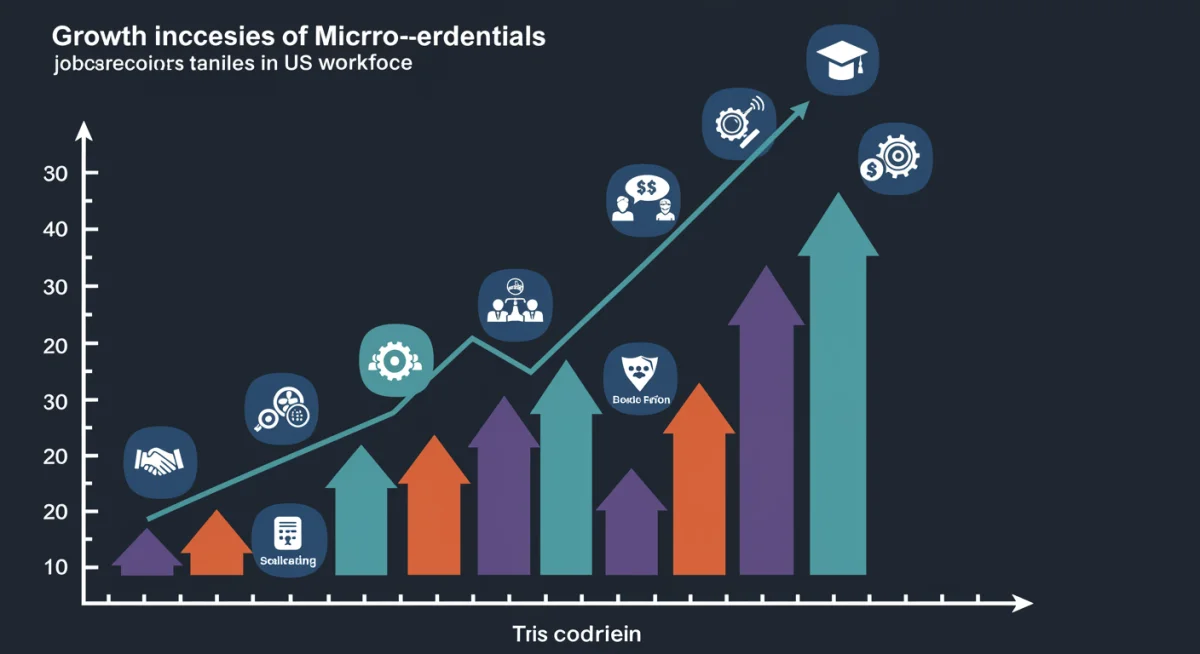Micro-credentials in US Higher Ed: 2025 Value Analysis

Anúncios
By 2025, micro-credentials in US higher education are increasingly recognized as vital for career advancement and addressing skill gaps, offering flexible, targeted learning pathways for a dynamic job market.
Have you noticed a shift in how skills are valued in today’s job market? The traditional four-year degree, while still foundational, is increasingly complemented by a new educational currency. The Rise of Micro-credentials in US Higher Education: A 2025 Analysis of Their Value reveals a significant transformation, offering targeted, flexible learning options that are reshaping career trajectories and workforce development across the nation.
Anúncios
Understanding the Micro-credential Phenomenon
Micro-credentials represent a fundamental shift in how we approach education and skill acquisition. Unlike traditional degrees that offer broad knowledge, these certifications focus on specific competencies, making them highly relevant to the demands of a rapidly evolving job market. Their modular nature allows individuals to acquire specialized skills quickly, addressing immediate professional needs without committing to lengthy academic programs.
The appeal of micro-credentials lies in their agility and direct applicability. As industries undergo digital transformations and new technologies emerge, the skills required to thrive are constantly changing. Micro-credentials provide a mechanism for continuous learning and upskilling, ensuring that the workforce remains competitive and adaptable. This responsiveness is a key factor driving their increasing adoption by both learners and employers.
Anúncios
Defining Micro-credentials in the US Context
In the United States, micro-credentials typically refer to verified certifications of a specific skill or competency, often awarded by higher education institutions, industry associations, or specialized training providers. They are distinct from badges or certificates of completion in that they usually involve a rigorous assessment process to ensure proficiency.
- Focused Learning Outcomes: Each micro-credential targets a clear, defined skill.
- Flexible Delivery: Often online or hybrid, catering to working professionals.
- Employer Recognition: Increasingly valued by companies seeking specific talents.
- Stackable Pathways: Can often be combined to form larger qualifications or degrees.
The clarity of purpose and the verifiable nature of micro-credentials make them attractive. They offer a transparent way for individuals to demonstrate their capabilities to potential employers, bridging the gap between academic learning and practical application. This clarity also helps employers identify candidates with the precise skills they need, streamlining hiring processes.
Ultimately, understanding micro-credentials means recognizing their role as a dynamic bridge between education and employment. They are not merely supplementary; they are becoming integral to a comprehensive strategy for lifelong learning and professional development, providing tangible evidence of skill mastery in a fast-paced world.
Driving Forces Behind Micro-credential Adoption
Several powerful trends are converging to accelerate the adoption of micro-credentials across the US higher education landscape. These forces reflect both the evolving needs of the workforce and the growing demands of learners for more flexible and relevant educational pathways. Recognizing these drivers is crucial to understanding why micro-credentials are not just a passing fad but a significant structural change.
The pace of technological change, in particular, has created an unprecedented demand for continuous skill development. Traditional degree programs often struggle to keep up with these rapid shifts, leading to skill gaps in critical areas. Micro-credentials offer a more nimble solution, allowing for the quick development and deployment of new learning modules that address these emerging needs directly.
Economic Imperatives and Skill Gaps
The US economy faces persistent skill gaps in sectors like technology, healthcare, and advanced manufacturing. Employers are actively seeking candidates with specific, demonstrable skills rather than just broad academic qualifications. Micro-credentials directly address this need by providing targeted training that can be quickly validated.
- Rapid Technological Advancements: New tools and platforms require constant upskilling.
- Industry Demand for Specialized Talent: Niche skills are highly sought after.
- Cost-Effectiveness for Employers: Investing in specific training rather than full degrees.
- Employee Retention and Development: Offering growth opportunities to current staff.
Beyond economic drivers, learner preferences are also playing a significant role. Today’s students, often juggling work and family responsibilities, seek educational options that are flexible, affordable, and directly applicable to their career goals. Micro-credentials fit this mold perfectly, offering bite-sized learning that can be integrated into busy schedules.
The financial aspect is also a significant motivator. Compared to the rising costs of traditional higher education, micro-credentials often present a more affordable entry point into specialized learning, democratizing access to valuable skills. This combination of economic necessity, industry demand, and learner preference forms a robust foundation for the continued growth of micro-credentials.
The Value Proposition for Learners and Employers
The increasing prominence of micro-credentials isn’t accidental; it’s driven by a clear value proposition for both individuals seeking career advancement and organizations striving to maintain a competitive edge. For learners, these credentials offer a direct pathway to acquiring in-demand skills, while for employers, they represent a strategic tool for workforce development and talent acquisition.
This dual benefit underscores their growing importance. Learners gain tangible evidence of their competencies, enhancing their employability and earning potential. Employers, in turn, can confidently invest in candidates or current staff who possess verified, up-to-date skills, reducing training costs and improving productivity.

Benefits for Individual Learners
For individuals, micro-credentials offer unparalleled flexibility and relevance. They can target specific skill gaps, pivot into new careers, or simply enhance their current professional profile without the time and financial commitment of a full degree program.
- Enhanced Employability: Demonstrable skills make candidates more attractive.
- Career Advancement: Acquire new competencies for promotions or new roles.
- Affordability and Accessibility: Often less expensive and more flexible than traditional degrees.
- Personalized Learning Paths: Tailor education to specific career goals.
Employers also gain significant advantages. In a competitive talent landscape, micro-credentials provide a reliable indicator of a candidate’s practical abilities. They allow companies to quickly identify and hire individuals who are job-ready, reducing the need for extensive on-the-job training.
Advantages for Organizations and Businesses
From an organizational perspective, micro-credentials are a powerful tool for strategic workforce planning. They enable companies to upskill their existing employees, ensuring their teams possess the latest capabilities needed to innovate and adapt to market changes.
- Closing Skill Gaps: Rapidly train employees in needed areas.
- Improved Talent Acquisition: Identify candidates with verified, specific skills.
- Increased Employee Retention: Offer development opportunities to valued staff.
- Enhanced Organizational Agility: Adapt quickly to new industry demands.
The mutual benefits create a virtuous cycle: as more learners acquire micro-credentials, their value in the job market increases, further incentivizing others to pursue them. This dynamic is rapidly solidifying the place of micro-credentials as a cornerstone of modern professional development.
Challenges and Opportunities in 2025
While the trajectory for micro-credentials in US higher education is overwhelmingly positive, the landscape for 2025 is not without its complexities. Several challenges must be addressed to ensure their continued growth and widespread acceptance, even as new opportunities emerge for innovation and integration.
One primary challenge revolves around standardization and quality assurance. Without a universal framework, the value of micro-credentials can vary significantly, leading to confusion for both learners and employers. Establishing clear guidelines for assessment and recognition will be crucial for building trust and ensuring consistent quality.
Navigating Recognition and Quality Assurance
A significant hurdle for micro-credentials is achieving consistent recognition and ensuring quality across diverse providers. Without a standardized framework, employers may struggle to evaluate their true value, and learners might question their investment.
- Lack of Universal Standards: Varying quality and assessment methods.
- Employer Skepticism: Some employers still prefer traditional degrees.
- Credit Transferability: Integrating micro-credentials into academic pathways.
- Ensuring Rigor: Maintaining high standards to prevent dilution of value.
However, these challenges also present significant opportunities. The demand for skilled workers continues to outpace the supply, creating a compelling case for institutions to embrace and refine micro-credential offerings. This market need can drive collaboration between academia and industry, leading to more relevant and impactful programs.
Emerging Opportunities for Growth
The opportunities surrounding micro-credentials are vast, particularly in areas where traditional education has been less agile. They can serve as powerful tools for workforce reskilling, addressing unemployment, and fostering innovation in rapidly evolving fields.
- Workforce Reskilling Initiatives: Addressing large-scale industry shifts.
- Partnerships with Industry: Co-creating highly relevant, job-focused programs.
- Personalized Learning Pathways: Tailoring education to individual career goals.
- Global Market Competitiveness: Equipping the US workforce with cutting-edge skills.
By proactively addressing issues of standardization and quality while capitalizing on market opportunities, micro-credentials can solidify their role as a transformative force in US higher education, creating a more responsive, equitable, and effective learning ecosystem.
Integration with Traditional Higher Education
The notion that micro-credentials compete directly with traditional degrees is gradually being replaced by a more nuanced understanding: they are increasingly seen as complementary, offering pathways for integration that enrich the overall educational experience. By 2025, many US higher education institutions are actively exploring and implementing strategies to weave micro-credentials into their existing offerings.
This integration can take various forms, from enabling students to earn micro-credentials alongside their degree programs to creating stackable pathways where a series of micro-credentials can culminate in a larger academic qualification. Such approaches leverage the strengths of both models, providing students with both broad foundational knowledge and targeted, in-demand skills.
Stackable Credentials and Pathways
One of the most promising avenues for integration is the concept of stackable credentials. This allows learners to earn individual micro-credentials that can then be combined or ‘stacked’ towards a larger certificate, associate’s degree, or even a bachelor’s degree. This modular approach offers significant flexibility and a clear progression path.
- Seamless Credit Transfer: Micro-credentials earning academic credit.
- Degree Acceleration: Using micro-credentials to fulfill degree requirements.
- Alternative Entry Points: Providing non-traditional students access to higher education.
- Hybrid Learning Models: Blending online micro-credentials with on-campus experiences.
The benefits of such integration extend beyond individual learners. Higher education institutions can enhance their relevance and attractiveness by offering more diverse and responsive programming. This can help them cater to a broader range of students, including working adults, who may not be able to commit to full-time traditional study.
Furthermore, integrating micro-credentials fosters a culture of lifelong learning within institutions. It encourages students to view their education as an ongoing process of skill acquisition and refinement, rather than a one-time event. This mindset is crucial for navigating the complexities of the modern workforce.
Enhancing Degree Programs with Specialized Skills
Beyond stackable pathways, micro-credentials can also serve to augment existing degree programs, providing students with specialized skills that make them more competitive in the job market. For example, a liberal arts student could earn a micro-credential in data analytics or digital marketing, adding a practical dimension to their foundational knowledge.
This approach addresses the common critique that traditional degrees sometimes lack direct career applicability. By embedding micro-credentials, universities can ensure their graduates possess both critical thinking skills and the specific technical or soft skills employers are actively seeking, creating a more well-rounded and job-ready individual.
The Future Landscape: 2025 and Beyond
As we look toward 2025 and beyond, the trajectory of micro-credentials in US higher education points towards an increasingly integrated and essential role within the learning ecosystem. The initial experimentation phase is giving way to more strategic adoption, with institutions, employers, and policymakers recognizing their transformative potential.
The future will likely see greater standardization and a more robust framework for quality assurance, making it easier for all stakeholders to understand and trust the value of these credentials. This will involve collaboration between accrediting bodies, industry leaders, and educational providers to develop common benchmarks and assessment practices.
Predictions for Micro-credential Evolution
By 2025, expect to see micro-credentials become a standard offering in most US higher education institutions, not just niche programs. Their evolution will be characterized by greater sophistication in design, delivery, and recognition.
- Widespread Institutional Adoption: Most universities will offer some form of micro-credential.
- Increased Employer Integration: Companies will actively seek and sponsor micro-credential training.
- Policy and Regulatory Frameworks: Governments will establish guidelines for quality and recognition.
- Enhanced Digital Credentials: Blockchain and other technologies for secure, verifiable records.
The emphasis will shift from simply offering micro-credentials to strategically aligning them with workforce needs and academic pathways. This will involve continuous dialogue between educational providers and industry to ensure that the skills being taught are directly relevant to current and future job demands.
Furthermore, the accessibility aspect of micro-credentials will continue to expand. Online delivery will remain dominant, but innovations in adaptive learning, virtual reality, and artificial intelligence will make the learning experience even more personalized and engaging. This will open up opportunities for a broader demographic of learners, including those in underserved communities.
Impact on Workforce Development and Lifelong Learning
The most profound impact of micro-credentials will be on workforce development and the concept of lifelong learning. They will normalize continuous upskilling and reskilling, making it an expected part of professional life rather than an exception.
This shift will empower individuals to remain agile in their careers, constantly adapting to new challenges and opportunities. For the US economy, it means a more resilient, skilled, and innovative workforce, capable of competing effectively on a global stage. Micro-credentials are not just about acquiring skills; they are about fostering a culture of continuous growth and adaptability.
Crafting a Strategy for Success with Micro-credentials
For individuals, institutions, and employers alike, successfully navigating the burgeoning landscape of micro-credentials requires a thoughtful and strategic approach. Simply offering or acquiring these credentials without a clear purpose risks diluting their potential value. Instead, a well-defined strategy can maximize their impact on career progression, institutional relevance, and workforce readiness.
For learners, this means carefully selecting micro-credentials that align with specific career goals and market demands. For educational institutions, it involves designing programs that are rigorous, relevant, and recognized. And for employers, it means integrating micro-credentials into talent management and professional development frameworks.
For Learners: Maximizing Your Investment
Individuals should approach micro-credentials with a clear understanding of their professional objectives. Researching industry trends and employer needs is paramount to selecting credentials that will truly enhance their career prospects.
- Identify Skill Gaps: Determine specific skills needed for career growth.
- Research Provider Reputation: Choose accredited or industry-recognized programs.
- Verify Employer Recognition: Understand how credentials are valued in your field.
- Plan Stackable Pathways: Consider how credentials can build towards larger goals.
The goal is not just to collect certificates, but to acquire demonstrable competencies that translate directly into professional opportunities. Engagement with the learning material, active application of skills, and networking within the micro-credential community can further amplify the return on investment.
For Institutions and Employers: Building a Robust Ecosystem
Educational institutions and employers have a shared responsibility in building a robust and trustworthy micro-credential ecosystem. This involves collaboration, quality assurance, and strategic integration into both academic and corporate structures.
- Develop Industry-Aligned Programs: Co-create content with employers.
- Implement Strong Assessment: Ensure verifiable and rigorous skill evaluation.
- Standardize Recognition: Advocate for clear frameworks and credit transfer.
- Promote Lifelong Learning Culture: Encourage continuous skill development.
By working together, these stakeholders can ensure that micro-credentials fulfill their promise as a powerful tool for bridging the gap between education and employment, ultimately benefiting individuals, businesses, and the economy at large. A strategic approach is the cornerstone of unlocking their full potential.
| Key Aspect | Brief Description |
|---|---|
| Market Demand | Driven by rapid technological change and industry skill gaps, requiring agile learning solutions. |
| Value Proposition | Offers targeted skills for learners and efficient workforce development for employers. |
| Integration with Higher Ed | Increasingly stackable and complementary to traditional degrees, enhancing relevance. |
| Future Outlook | Greater standardization, widespread adoption, and critical for lifelong learning by 2025. |
Frequently Asked Questions About Micro-credentials
A micro-credential is a verified certification of a specific skill or competency, typically much shorter than a traditional degree. It often involves a rigorous assessment to ensure proficiency in a targeted area, making it highly relevant for professional development and direct application in the workforce.
Institutions benefit by offering flexible, in-demand learning options, attracting diverse learners, and staying relevant in a rapidly changing job market. They can also integrate these credentials into existing programs, creating stackable pathways and enhancing the career readiness of their graduates.
Yes, employer recognition is growing significantly, especially for credentials aligned with specific industry needs and skills gaps. Many companies actively seek candidates with verified micro-credentials, viewing them as tangible proof of job-ready competencies and a commitment to continuous learning.
Increasingly, yes. Many institutions are developing ‘stackable’ pathways where micro-credentials can accumulate academic credit or serve as prerequisites for larger certificates or degree programs. This provides flexible routes for learners to progressively build towards higher qualifications.
Key challenges include establishing consistent quality assurance and standardization across diverse providers, ensuring broad employer recognition, and integrating them seamlessly into existing academic credit systems. Overcoming these will be crucial for their long-term success and widespread adoption.
Conclusion
The analysis of The Rise of Micro-credentials in US Higher Education: A 2025 Analysis of Their Value clearly indicates a pivotal shift in how skills are acquired, validated, and valued. These targeted, flexible learning units are not merely an add-on; they are becoming an indispensable component of a responsive educational ecosystem, bridging the gap between academic offerings and the dynamic demands of the modern workforce. As we move further into 2025, their strategic integration within traditional higher education, coupled with increasing employer recognition and a commitment to quality assurance, will solidify micro-credentials as a cornerstone of lifelong learning and professional agility. Both individuals and institutions stand to gain immensely by embracing this transformative trend, ensuring a more skilled, adaptable, and competitive future for the United States.





